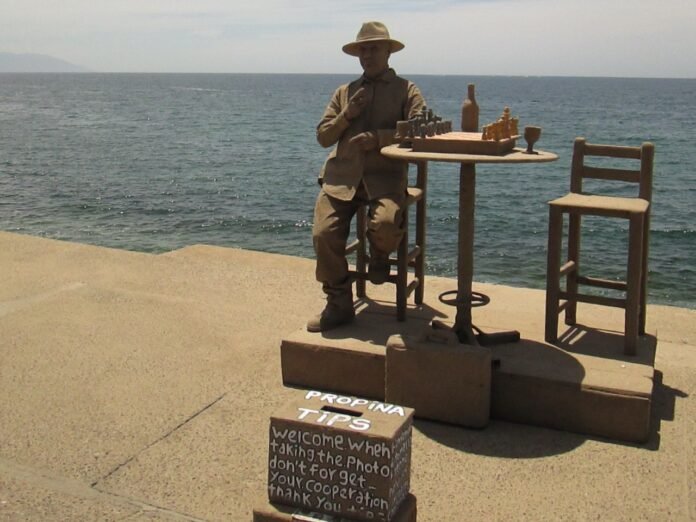By Arlene Pervin, Moderator Vallarta Writers Group
Roberto dresses in his sand-coated khaki pants, shoes, shirt, and fedora clothes. He pats the finishing touches of mud and sand onto the back of his neck, face, and hands.
The clothes look heavy and stiff. The creases in his pants and shirt sleeves look like ridges in a still-life sculpture.
“¿Muy pesado?” I ask. “Cuatro kilos,” he answers. I think about the extra weight of wearing this taupe-colored garb in the tropical heat, sitting for hours on the Malecon in the heart of Puerto Vallarta. Luis, too, dressed in identical garb. They call themselves the sand men.
It is a scene, a set, a one-act play with two silent players cast in sand. The stage is the Malecon.
The set, a small card table, three chairs, a chessboard, chess pieces, two wine goblets, and two carafes, all coated in sand. The lighting has the look of a mud-matte finish.
The sand men sit there all day. Human sand statues. A foot away from the card table, there’s a cardboard box covered with brown paper with an opening at the top. It says ‘tips.’ Near it, another sign says, “Somos de arena y regresamos al arena” or, in English, “We are sand, and we return to sand.” Near the foot of the table sits a sand-covered suitcase.
“They’re real,” gasps a woman to her husband as she walks by the table where the men sit posed.
“Come take a picture with us,” says one of the sand men. Like so many others, she continues walking. There’s a third chair at the table where one can sit with them. When a person stops to sit with them, they pour sand from a coated carafe into their sand-covered goblets and lift them to their sand-coated lips, raising a toast.
There are many hours when crowds stream by, not seeing the set or scene, not interacting with this stationary play on the sidelines. There are hours when no one stops to sit with them or take their picture, and no coins drop into the box, and still, they sit there in the beating sun.
That’s when they play chess, for real, to pass the time.
One day, I sat with the sand men to hear a grain of their story. “How many years have you been a sand man?” I asked. “Eleven,” Roberto said. Then he pointed to Luis and said, “Ten.”
I asked them who had come up with the idea of being sand men, and Roberto admitted it was his idea.
My mind wanted all the details of what made him become a sandman, what went before, and what would follow. Still, I couldn’t bring myself to cross that barrier, not wanting to hear about the sheer necessity, hunger, or desperation, so instead, I praised his creativity and its brilliant execution. There was only the now.
I wonder if they can read people’s minds and sense beforehand if someone will reach into their pockets and drop coins or just walk by oblivious to them, carrying their aloof attitude, as if looking will obligate them to feel guilty for not giving.
I think about how their skin feels every night and worry about the long-term effects they might feel years down the road from the harshness of the sea, salt, sand, and sun on their hands and faces and ponder the patience they must execute as they sit like statues, moving only when someone comes to sit with them or stop long enough to take their picture.
I contemplate the meditative skills they must have, or maybe it’s just the blind endurance to earn pesos for tacos and survival. What mantra would I repeat to keep me there and give me the fortitude and patience to take their place for even a day?
There have been different sand men over the years. A few faces are taking on the role, but I suspect it is a brutal audition, sitting for six to eight hours in a postcard scene, and there must be only a few rare applicants that can succumb, suffer, and persevere in a sand man’s kind of life.
One day, I saw Roberto with a large paintbrush; he was on the beach near where they sat. I saw his face without the sand and mud. It was a refreshing relief.
He had a shirt and pants laid out on the beach and was coating them with dark mud that he mixed with a bit of water. Then he tossed beach sand on the clothing, preparing their garb for the day.
I asked if the mud came from the sea, fishing for details of what they used to transpose themselves into sand men. “We buy the mud,” Roberto revealed, “but the sand is this,” he said, pointing to the beach.
I watched as Roberto used the muddy mix to paint the face of a new sand man. I just happened to catch the moment. Like painting the form of a bust, he covered the back of the neck, forehead, and other facial features, including eyelids and upper lip. Then, with handfuls grabbed from the beach, he tossed the fine sand onto the muddy undercoating of a face.
It completed the picture and readied to sit as human sand statues for the day. Like a game of chess, of winners and losers, of check and mate, I question whether fate or circumstance has turned them into sand men, living art, for a few dropped coins.
One day I asked Roberto what the suitcase was for. “That’s for the money, for when we go on a trip,” he said. “Oh,” I muttered, trying to imagine the likelihood of that possibility for them.
I could only think that the suitcase symbolizes the dream of escaping, traveling to distant lands, taking journeys, and hoping for change. For we all need dreams, even sand men.


